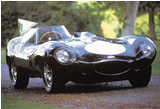
SPECIFICATION
Engine:
Straight six; 83 x 106 mm, 3442 cc; twin ohc; max power 245 bhp at 5,500 rpm (1956 277 bhp at 6,000 rpm) Also 78 x 106 mm 3,781 cc 306 bhp at 5,500 rpm
Transmission:
Four speed manual
Suspension:
Front, independent by wishbones, torsion bars and dampers:Rear live axle, trailing arms, transverse torsion bars and dampers
Brakes:
Disc brakes
Dimensions:
Wheelbase: 90.5 in (230cm);
Track: Front, 50 in (127 cm);
Rear: 48 in (122 cm)
Max speed:
Approx 160 mph (257 kmh)
|
Jaguar D-Type 1954/56
Laid down as a successor to Jaguar's C-Type, this was to become the most famous of all sports-racing cars and unlike some, a fair number were produced. It won the Le Mans 24-Hour race 1955-57, yet as docile enough to be driven on public roads.
New concept
Some components were carried over from other Jaguars, but under the svelte overall shape, by aerodynamicist Malcom Sayer, there was a new elliptical magnesium-alloy centre section monocoque, with substantial bulkheads front and rear. A subframe carried front suspension and engine, another at the rear the fuel tank and spare wheel, while the suspension trailing arms located to the bulkhead. From 1955 long and short nose bodies were used, with screens wrapping around the driver or full width.
Success
Narrowly beaten first time out, a D won its second race at Reims in 1954. A works team car won at Le Mans in 1955 and Ecurie Ecosse D-Types won the Franch classic in 1956-57. Although often regarded as a "smooth track special" because if its rear suspension the D won countless other races though the late 1950's
The D looks fast even when standing still. The lines where the understressed front and rear bodywork merged into the monocoque centre section can be seen.
Photo Autopresse
MCMXCI, Edito-Service S.A. D1 078 01-14
|